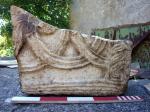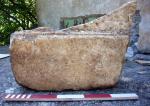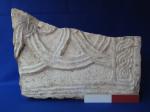
Illustrations
- No uploaded files
Descrizione
- Medieval low relief
- White marble
- 1
- 52.0
- 37.0
- 14.0
- A large fragment carved on one side and roughly finished on two adjacent edges. The piece has suffered major breaks.
- AE 1039, one of the largest of the low relief fragments to survive, was carved on a single face, which preserves three distinct tri-band patterns. The primary motif at center is a series of intertwining, overlapping circles. Only three partial circles remain. At the center of each circle, tri-band strands twist into a knot. A bunch of grapes, schematically rendered, emerges from one of these knots, transforming the geometrical interlace into an abstract vegetal pattern. It is unclear if the motif repeated, as it typically did, or ended (in the broken corner of the fragment, the tri-band does not reappear on the far side of the knot as one would expect if the pattern repeated). A tri-band guilloche pattern, bounded on either side by smooth, raised bands; and a so-called saw-tooth band serve as boarders edging two sides of the block. The quality of the carving is poor; the recessed surfaces were only roughly finished.
- The interlocking circles motif was found throughout central and northern Italy and as far north as Croatia (Verzone 1945, 178–79; for a fairly comprehensive list of examples see Pani Ermini 1974, vol. 1, 69–70 and 1974, vol. 2, 91–92). The pattern was common in Rome. Pani Ermini associates it with building projects undertaken during the pontificate of Leo III (795–816) (1974, vol. 1, 70). The Villamagna example can be compared to fragments from S. Andrea Cata Barbara (795–816; Pani Ermini 1974, vol. 1, no. 14), S. Maria in Cosmedin, (Verzone 1945, 179 no. 4), Trajan's Market (first half of the ninth century; Pani Ermini 1974, vol. 2, no. 108) and S. Saba (ca 950; Trinci Cecchelli 1976, nos 98, 100 and 101). Examples outside of Rome (quite far afield) include pilaster fragments from the Duomo of Sutri (ninth century; Raspi Serra 1974, nos 305–07), S. Colombano, Bobbio (ninth century; Verzone 1945, 179 no. 6) and Castelvecchio, Tesona (tenth century; Verzone 1945, 179 no. 8).
- The central circle motif on AE 1039 is similar to the grid of interlocking circles seen on AE 1069. The likeness, however is limited. Whereas the pattern on AE 1069 extends to the very edge of the block and is neatly reconciled in a series of half circles, the pattern on AE 1039 ends abruptly where it meets the guilloche frame. There is also a significant disparity in the craftmanship. Though AE 1069 is carved from limestone, a poorer material, whoever sculpted it worked with far greater precision and exactitude.















![Download [view]](/villamagna/ark//skins/villamagna/images/results/download_sml.png)


